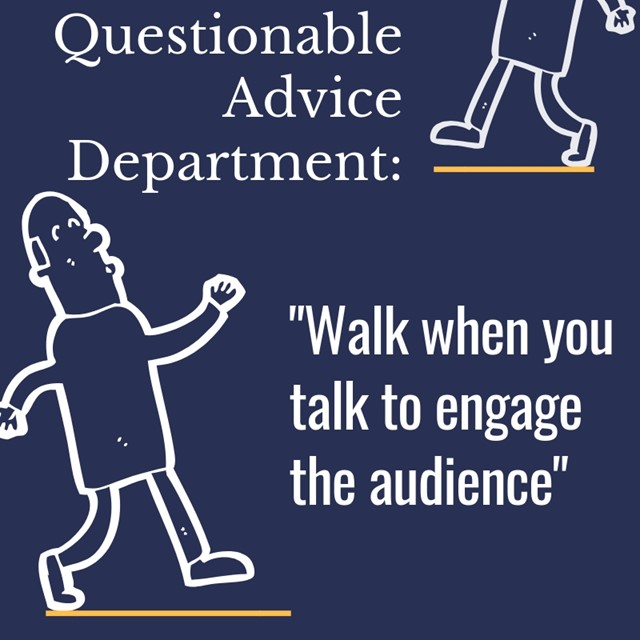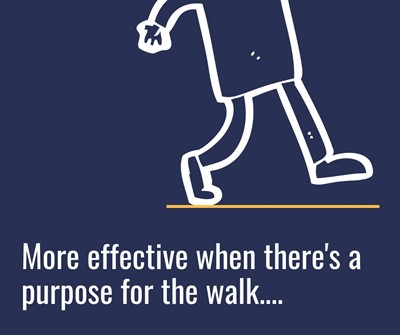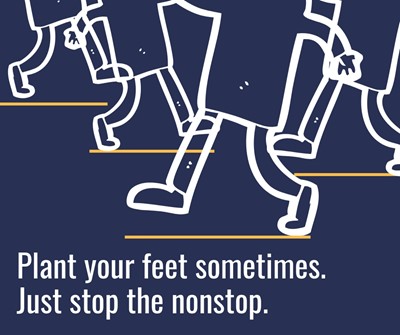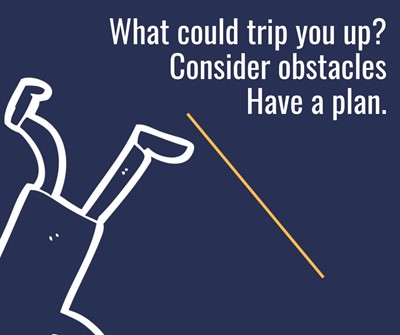
"I'd much rather watch Tony Robbins wander around the stage than hide behind a lectern."
– Blog post on the pros and cons of walking during a presentation
"I’m a walker." A good number of people who attend our programs will tell us this, as if pacing side to side on a stage is a physical trait—like eye color—over which they have no control.
Other speakers say it’s essential to walk around the stage—and into the audience. They’ve seen other speakers do it. They believe it conveys energy. They think it improves the speaker’s connection to the audience.
There’s some truth in all of the above. Some people ARE more inclined to rove the stage. Some speakers ARE more effective when they move around and even into the audience.
But walking is not enough to make you a more dynamic speaker—and can, in fact, make you a less effective speaker. Before you start stalking around the stage, here’s what you need to know.

1. Walk for a reason.
Moving around the stage is effective, when you do it for a purpose.
For example, perhaps you’re standing at the lectern to deliver some hard-hitting facts. Then you want to humanize those facts with a story.
You could walk away from the lectern and toward the audience.
What does this do?
It provides a natural transition in tone. By moving from behind the lectern, you remove the barrier between yourself and the audience. You indicate that you want to change the relationship with them and with your material—from formal to less formal, from objective to intimate.
Once you start thinking as walking as another way to deliberately add meaning to your talks, you can see all sorts of possibilities:
- You can move from one side of the room to the other as you shift topics.
- You can ask a rhetorical question, take a few steps while the audience considers it, then stop and provide your answer.
- You can tell a funny story, and while the audience is laughing, you can reposition yourself to take up your next serious point.
This kind of choreography has no impact, of course, if you walk all the time (see next point).
There are also a couple of other pitfalls to keep in mind:
- Avoid falling into discernible patterns.
For example, if you fall into the pattern of walking three steps and delivering a point, the audience will pick up on the pattern. They’ll start to watch for the pattern and be distracted from listening to you. - Don’t be too staged.
While we’re talking about using the stage in a deliberate way, you want to appear natural in your movements. Your walking should seem to spring naturally for your message. To achieve this unpracticed look, you may (oddly enough) have to practice.
Remember, too: There are other ways you can move (gestures, body language, facial expressions) that add dynamism and don’t involve walking.

2. Don’t roam nonstop.
We’ve already hinted at this—and it’s pretty simple: Walk to get to a place on the stage or in the room. Then stand there. Plant your feet. Make a point. Be there for a while before you move again.
Speakers who roam nonstop not only deprive themselves of a terrific tool—choreography and smart use of the stage—they also communicate energy that’s not under control.
We’ve heard a lot of negative feedback from audiences about speakers who wander nonstop around the stage. It’s the biggest negative we hear about the TED format, despite the TED talk’s many charms.
For audiences, non-stop pacing is, at best distracting. At its worst, it is off-putting and agitating:
- Some audiences will attribute arrogance to a speaker who paces nonstop.
- Others will believe the speaker is uncomfortable with his stance, because he does not literally “take a stand.”
- And it can be a sure indicator of nervous energy that’s not under control, something else audiences will pick up on.
As we said, the solution is to walk to some point in the room, then stop and speak from that point for a while, before walking again.

3. Make sure it’s going to work, on the practical level.
When you walk around a stage, you do in fact bring yourself closer to some members of the audience. You also take yourself farther away from others.
Before you decide to “work the room,” be sure it’s going to work. Consider:
- Will they be able to hear me? When you’re using a sound system, be sure that walking doesn’t mean you’ll leave the microphone behind. When you’re relying on your voice to project without help, does walking keep some people from hearing you as clearly as possible?
- Will I be shutting people out?
This often happens when a speaker walks into an audience or roams around a room. Will you be turning your back on a section of your audience? How will this affect your delivery—and is the payoff worth it? - Does my physical position in the room send an unintended message?
If you’re talking about disappointing results from a project, for example, does moving to one side of the room suggest those people are the ones who let you down? Be careful not to associate bad things with certain people just because you walked over to stand near them. - Are there obstacles that can trip me up?
Are there cables taped to the conference room floor? Steps you have to go up and down to get into the audience? Tight spaces? If you have to struggle to stay on your feet, walking may not be worth the potential distractions.
So yes, walking CAN add energy to a presentation. But random pacing, for the sake of moving around, is not the best approach. Send a better message by being deliberate and being controlled.






